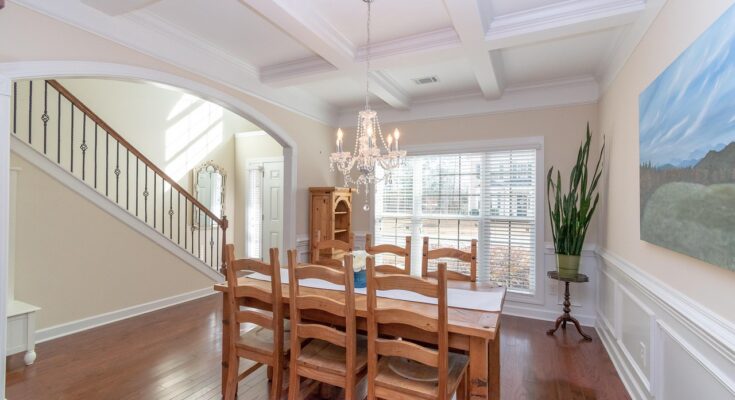ZonaJakarta – We all want our homes to feel open, airy, and welcoming—but what if your ceiling is doing the opposite? If your room has a low ceiling, you’re not alone. Many apartments, older homes, and basement spaces come with a lower vertical limit, making the room feel a bit boxed in or cramped.
But here’s the good news: you don’t need a renovation crew to raise the roof—just the right paint color can do wonders. With a few smart choices, your walls (and your ceiling) can trick the eye and create a sense of height, depth, and balance.
So if you’re staring at your space and wondering how to make it feel taller without knocking down walls, here’s your go-to guide for using paint to give low ceilings a lift.
1. Light Colors Really Do Work—But It’s About the Right Kind
You’ve probably heard this before: “Light colors make a room feel bigger.” That’s true—but not all light shades are created equal. If you’ve got a low ceiling, your best bet is to stick with soft, airy tones that bounce light and visually expand the space.
Think whites, pale grays, cool blues, or warm beiges. These colors help walls blend into the ceiling instead of stopping the eye short. The result? Your space feels taller, lighter, and less “boxy.”
But watch out: too stark a white can make the room feel sterile—or worse, highlight shadows and imperfections on your ceiling. Choose a white with a bit of warmth or softness, depending on the natural light your space gets.
2. Match Your Ceiling to Your Walls—Seriously
One of the best tricks in the book: paint your ceiling the same color as your walls—or just a shade lighter. This eliminates the harsh contrast between wall and ceiling, which is often what visually “chops” the room in half.
When everything flows together, your eye moves upward without interruption, making the ceiling feel farther away than it actually is. It’s a subtle shift, but the impact can be huge.
This approach works especially well in smaller rooms like bedrooms, hallways, or compact living areas where visual cohesion is key.
3. Go Matte, Not Glossy
It might be tempting to use a high-gloss paint for its light-reflecting qualities, but for a low ceiling? Not a great idea.
Glossy finishes can highlight every bump and flaw—and in smaller, low spaces, they can create glare instead of glow. Instead, opt for a matte or eggshell finish, which gives a smooth, soft appearance and helps absorb just enough light to make things feel calm and open.
Bonus: matte paint gives your ceiling a gentle, cloud-like texture—exactly the kind of vibe you want when trying to create a sense of airiness.
4. Consider Color Psychology, Too
Color isn’t just visual—it’s emotional. In low-ceiling spaces where things might already feel a bit “tight,” certain hues can help shift the mood in a more relaxed direction.
For example, soft cool tones like dusty blue, pale sage, or lavender can calm the mind and give a sense of openness, especially when paired with light fabrics and minimal furniture.
If you prefer warmth, muted earth tones like clay, peach, or warm taupe can create a cozy, grounded feel without overwhelming the ceiling height. Just avoid overly dark or saturated shades unless you’re going for a dramatic, moody look—which can work, but needs to be intentional.
5. Paint Vertical Elements with Intention
Want to exaggerate height even more? Use paint to your advantage by drawing the eye upward.
Vertical stripes—even subtle ones in similar tones—can visually stretch the room. Or, if you’re feeling bold, consider painting a narrow “accent panel” from floor to ceiling behind a piece of furniture or artwork. It creates a column effect that tricks the eye into thinking the space is taller.
Similarly, painting your trim and moldings the same color as your walls can make the edges disappear, further softening boundaries and boosting the illusion of height.
6. It’s Not Just the Paint—It’s What You Pair With It
Paint sets the tone, but your lighting and decor complete the illusion. Use tall floor lamps, sheer curtains mounted close to the ceiling, and vertical artwork to support your upward design goal.
And remember—clutter can shrink a room faster than a dark color ever could. Keeping things simple and streamlined helps your low-ceiling room feel like it’s breathing easy.
Final Thought: The Ceiling Might Be Low, But Your Style Doesn’t Have to Be
Living with a low ceiling isn’t a design death sentence—it’s just a creative challenge. With the right paint strategy, you can transform your space from “meh” to magical, making every inch count and every angle work in your favor.
So next time you stand in that room and feel like it’s closing in, grab a brush and remind yourself: the only thing truly limiting your space is the color you haven’t tried yet. (*)




